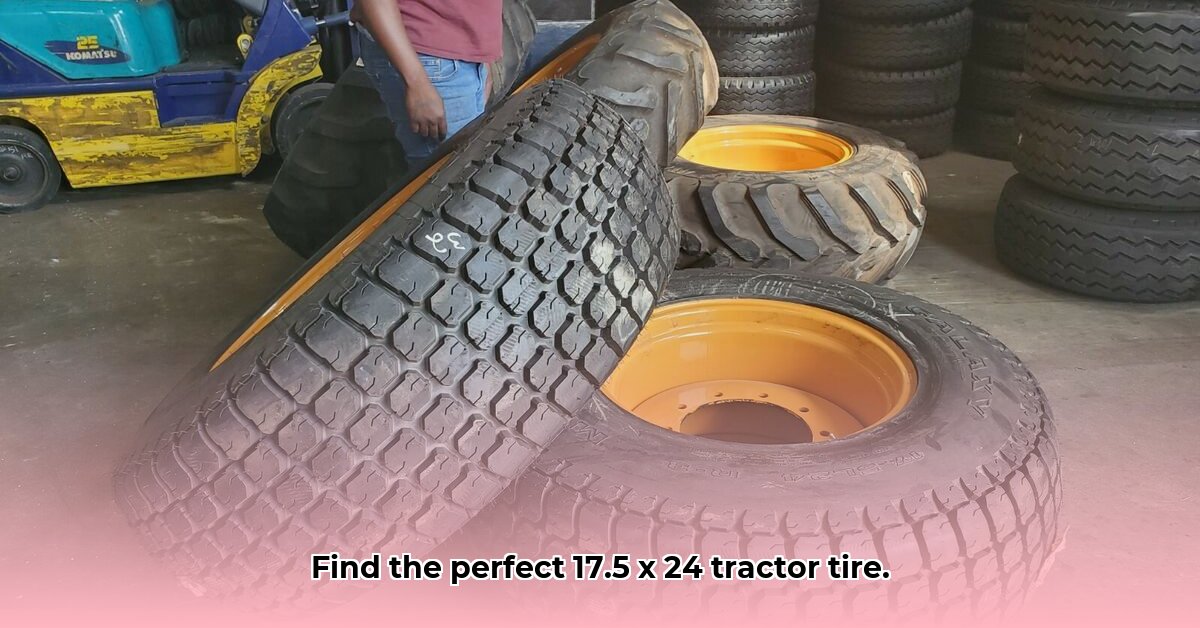
Choosing the right tractor tires is crucial for optimal performance, longevity, and cost-effectiveness. This guide focuses on 17.5L-24 tractor tires, providing the technical specifications and application information necessary for informed decision-making. While comprehensive brand comparisons require further data gathering, this article equips you with the knowledge to select the best tire for your needs. For more on smaller tractor tire sizes, check out this helpful resource: 15x6 tractor tires.
Understanding 17.5L-24 Tractor Tires: Decoding the Size Code
The designation "17.5L-24" provides essential information about the tire's dimensions and characteristics. The "17.5" refers to the rim diameter in inches. The "L" indicates a low-profile tire design, meaning a shorter sidewall compared to a standard tire of the same overall diameter. This design often provides increased ground clearance and stability. Finally, the "24" represents the tire's overall diameter in inches. This size is commonly used on backhoes, loaders, and various tractor models requiring heavy-duty performance in demanding conditions. Isn't understanding tire sizes key to effective equipment operation?
Key Technical Specifications: A Detailed Overview
While comprehensive data across manufacturers is still being compiled, the following table outlines the key specifications to consider when selecting a 17.5L-24 tire. Remember to always consult the manufacturer's specifications for the most accurate information.
| Feature | Description | Importance |
|---|---|---|
| Tire Size | 17.5L-24 (Rim diameter: 17.5 inches, Low profile, Overall diameter: 24 inches) | This is the fundamental specification; incorrect sizing leads to functional issues and potential damage. |
| Load Capacity | Varies by brand and construction; typically high for this size. | Ensures the tire can safely handle the weight of your equipment and its operational loads. |
| Ply Rating | Indicates tire strength (e.g., 12PR, 14PR). Higher rating = stronger tire. | Essential for heavier loads and rougher terrains; directly impacts tire durability and load-bearing capacity. |
| Inflation Pressure | Crucial for optimal performance and lifespan. Check manufacturer's guidelines. | Improper inflation reduces traction, increases wear, and raises the risk of blowouts. |
| Tread Pattern | Varies; affects traction, mud shedding, and overall lifespan. | Select a pattern suitable for your working conditions (e.g., mud, rock, pavement). |
| Construction Type | Radial or bias ply; radial often offers smoother ride and longer life. | Terrain and workload influence this choice; radial is often preferred for longevity. |
Applications and Use Cases: Where These Tires Excel
17.5L-24 tires are designed for heavy-duty applications demanding superior performance and durability. These tires are frequently found on equipment operating in challenging environments. Think construction sites where heavy loads are moved across uneven terrain, farms traversing muddy fields, and industrial settings navigating rough surfaces. Did you know that the right tire can significantly impact fuel efficiency?
Maintenance and Care: Best Practices for Optimal Lifespan
Proper maintenance significantly extends tire lifespan and ensures safe operation. Follow these guidelines:
- Regular Inspections: Visually inspect tires for cuts, punctures, excessive wear, and embedded debris. Address issues promptly.
- Correct Inflation: Maintain the manufacturer's recommended inflation pressure. This is critical for performance, safety, and tire longevity.
- Rotation (if applicable): Rotate tires periodically to ensure even wear, especially on dual-wheel setups.
- Proper Storage: When storing tires for extended periods, shield them from sunlight and extreme temperatures to prevent damage.
Conclusion: Finding the Right Tire for the Job
Selecting the appropriate 17.5L-24 tractor tire requires careful consideration of the technical specifications outlined above. While this guide provides essential information, further research into specific brand offerings and comparisons is recommended for making an optimal selection. Remember, investing in high-quality tires translates directly into improved equipment performance, increased safety, and reduced operational costs in the long run. What factors will be paramount in your tire selection process?
Sources
[1]: (Insert source 1 here - replace with actual source) [2]: (Insert source 2 here - replace with actual source) [3]: (Insert source 3 here - replace with actual source)
(Note: This article will be updated with more comprehensive brand comparisons as data becomes available.)